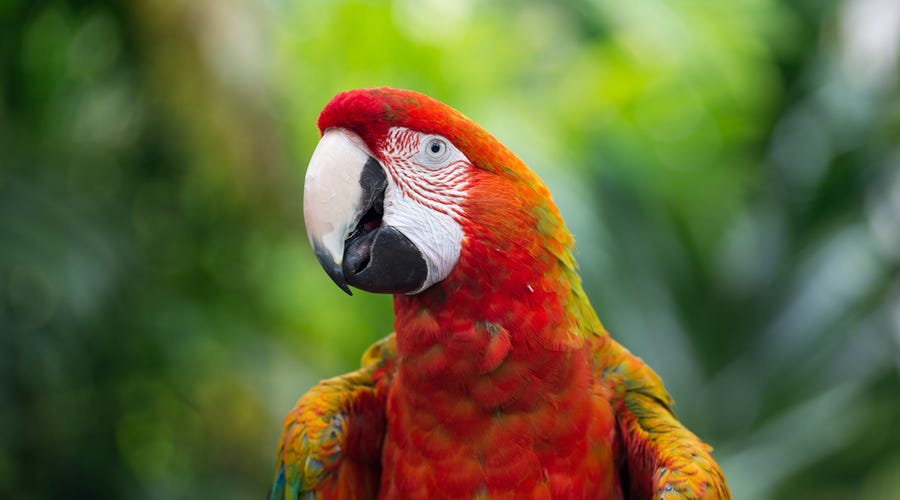
A funny, fascinating, feathery guide to 130 names of birds in Spanish
Author: Marco Monroy
Every animal lover will want to learn all the different birds in Spanish.
Whether you already have some pet birds or simply admire their grace and untethered lifestyle, you probably want to learn a few names of birds in Spanish. These fascinating creatures come in all shapes and sizes, some of which have very special abilities and features.
Even if you’re not a huge fan of birds, learning about them will help you:
- Identify exotic bird species as you travel through Latin America.
- Understand bird-related phrases and sayings in Spanish.
- Learn more about the animal kingdom in Spanish.
With hundreds and hundreds of different species, it’s practically impossible to cover every single one in one go. However, this handy guide will cover over 100 of the most common bird species to get you started. You’ll learn many popular birds, from how to say owl in Spanish to how to say eagle in Spanish.
Ready to get started? ¡Vámonos!

How to say “bird” in Spanish
There are two main ways to say bird in Spanish: ave and pájaro. The main difference between the two is quite simple:
| English | Spanish (singular) | Spanish (plural) | IPA pronunciation | Use |
|---|---|---|---|---|
| Bird | El ave | Las aves | las ˈaβes | Includes all birds regardless of size or ability |
| Bird | El pájaro | Los pájaros | los ˈpaxaɾos | Only applies to small birds that can fly |
One other thing to note is the article use. You may have noticed that el ave uses the masculine article “el” while las aves uses the feminine article “las.” This is because the word ave is really feminine, but the article has to be switched due to phonetics.
This only happens when two conditions are met. First, the first letter of a feminine word has to be an -a. Then, the tonic (stressed) syllable has to be the first syllable of the word. Then, the feminine singular article has to be switched to prevent two consecutive stressed a’s. For example:
- El águila
- La alfombra (no change because the first syllable is not the tonic syllable)
- El agua
Keep in mind that these only apply to singular nouns, as plural nouns use the corresponding article “las.” The -s at the end breaks up the consecutive a’s, which is why you won’t need to change the article from feminine to masculine.
Very common birds in Spanish
Alright, now that you know how to talk about birds in general, let’s get more specific. Below are a few dozen of the most common ones in Spanish. This little table is just an intro to get you familiar with the basics, so we’ll cover common birds from doves in Spanish to cranes in Spanish!

| English | Bird name (singular) | Bird name (plural) | IPA pronunciation |
|---|---|---|---|
| Pigeon | El pichón | Los pichones | piˈʧõn |
| Dove | La paloma | Las palomas | paˈloma |
| Sparrow | El gorrión | Los gorriones | ɣoˈrjõn |
| Eagle | El águila | Las águilas | ˈaɣila |
| Hummingbird | El colibrí | Los colibríes | koliˈβɾi |
| Chicken | La gallina | Las gallinas | ɣaˈʝina |
| Swan | El cisne | Los cisnes | ˈsis̬ne |
| Rooster | El gallo | Los gallos | ˈɣaʝo |
| Owl | El búho | Los búhos | ˈβuo |
| Barn owl | La lechuza | Las lechuzas | leˈʧusa |
| Snow owl | El búho de las nieves | Los búhos de las nieves | ˈβuo ðe las̬ ˈnjeβes |
| Crow | El cuervo | Los cuervos | ˈkwɛɾβo |
| Goose | El ganso | Los gansos | ˈɣãnso |
| Duck | El pato | Los patos | ˈpato |
| Turkey | El pavo | Los pavos | ˈpaβo |
| Finch | El fringílido | Los fringílidos | fɾĩnˈxiliðo |
| Osprey | El águila pescadora | Las águilas pescadoras | ˈaɣila pɛskaˈðoɾa |
| Mallard | El ánade real | Los ánades reales | ˈanaðe reˈal |
| Woodpecker | El pájaro carpintero | Los pájaros carpinteros | ˈpaxaɾo kaɾpĩnˈtɛɾo |
| Vulture | El buitre | Los buitres | ˈβwitɾe |
| Mockingbird | El sinsonte | Los sinsontes | sĩnˈsõnte |
| Hawk | El halcón | Los halcones | alˈkõn |
| Bald eagle | El águila calva | Las águilas calvas | ˈaɣila ˈkalβa |
| Cardinal | El cardenal | Los cardenales | kaɾðeˈnal |
| Seagull | La gaviota | Las gaviotas | ɣaˈβjota |
| Robin | El petirrojo | Los petirrojos | pɛtiˈroxo |
| Parrot | El loro | Los loros | ˈloɾo |
| Crane | La grulla | Las grullas | ˈɣɾuʝa |
| Flamingo | El flamenco | Los flamencos | flaˈmɛ̃nko |
| Pelican | El pelícano | Los pelícanos | peˈlikano |
| Quail | La codorniz | Las codornices | koðoɾˈnis |
| Partridge | La perdiz | Las perdices | pɛɾˈðis |
Migratory birds in Spanish
Let’s get even more specific. If you’re a bird fan or are simply looking to move into intermediate Spanish, then you’re gonna want to learn a few of the following migratory birds in Spanish. Many of them don’t generally come up in casual conversation—but when they do, you’ll be happy you studied them!

| English | Bird name (singular) | Bird name (plural) | IPA pronunciation |
|---|---|---|---|
| Goldfinch | El jilguero | Los jilgueros | xilˈɣɛɾo |
| Oriole | El oriol | Los orioles | oˈɾjol |
| Chickadee | El carbonero | Los carboneros | kaɾβoˈnɛɾo |
| Grosbeak | El trincapinones | Los trincapinones | tɾĩnkapiˈnones |
| Blue Jay | El arrendajo azul | Los arrendajos azules | arɛ̃nˈdaxo aˈsul |
| Blackbird | El mirlo | Los mirlos | ˈmiɾlo |
| Thrasher | El zorzal | Los zorzales | soɾˈsal |
| Swift | El vencejo | Los vencejos | bɛ̃nˈsexo |
| Waxwing | El ampelis | Los ampelis | ãmˈpelis |
| Albatross | El albatros | Los albatros | alˈβatɾos |
| Redpoll | El pinzón | Los pinzones | pĩnˈsõn |
| Wren | El chochín | Los chochines | ʧoˈʧĩn |
| Bunting | El escribano | Los escribanos | ɛskɾiˈβano |
| Swallow | La golondrina | Las golondrinas | ɣolõnˈdɾina |
| Falcon | El falco | Los falcos | ˈfalko |
| Kinglet | El reyezuelo | Los reyezuelos | reʝeˈswelo |
| Starling | El estornino pinto | Los estorninos pintos | ɛstoɾˈnino ˈpĩnto |
| Titmouse | El herrerillo | Los herrerillos | ɛrɛˈɾiʝo |
| Thrush | El túrido | Los túridos | ˈtuɾiðo |
| Meadowlark | La alondra | Las alondras | aˈlõndɾa |
| Magpie | La urraca | Las urracas | u̯ˈraka |
| Grassbird | La yerbera | Las yerberas | ʝɛɾˈβɛɾa |
| Nuthatch | El trepatroncos | Los trepatroncos | tɾepaˈtɾõnkos |
| Warbler | La curruca | Las currucas | kuˈruka |
Wild / Exotic birds in Spanish
One of the best parts about learning a new language is being able to explore and discover things you didn’t know about before. If you’re looking to travel through Latin America, you’ll likely run into some very interesting tropical birds! Here are some of our favorites.

| English | Bird name (singular) | Bird name (plural) | IPA pronunciation |
|---|---|---|---|
| Toucan | El tucán | Los tucanes | tuˈkãn |
| Macaw | La guacamaya | Las guacamayas | ɣwakaˈmaʝa |
| Hornbill | El cálao | Los cálaos | ˈkalao |
| Atlantic Puffin | El frailecillo | Los frailecillos | fɾai̯leˈsiʝo |
| Flycatcher | El muscicápido | Los muscicápidos | musiˈkapiðo |
| Aracari | El arasarí | Los arasaríes | aɾasaˈɾi |
| Bali Bird of Paradise | El ave del paraíso esmeralda grande | Las aves del paraíso esmeralda grande | ˈaβe ðɛl paɾaˈiso ɛs̬mɛˈɾalda ˈɣɾãnde |
| Kingfisher | El martín pescador | Los martines pescadores | maɾˈtĩm pɛskaˈðoɾ |
| African Crowned Crane | La grulla coronada cuelligrís | Las grullas coronadas cuelligrís | ˈɣɾuʝa koɾoˈnaða kweʝiˈɣɾis |
| Hoopoe | La abubilla | Las abubillas | aβuˈβiʝa |
| Heron | La garza | Las garzas | ˈɣaɾsa |
| Condor | El cóndor | Los cóndores | ˈkõndoɾ |
| Peacock | El pavo real | Los pavo reales | ˈpaβo reˈal |
| Quetzal | El quetzal | Los quetzales | kɛtˈsal |
| Roadrunner | El correcaminos | Los correcaminos | korekaˈminos |
| Barbet | El barbudo | Los barbudos | βaɾˈβuðo |
| Red-Bearded Bee-Eater | El abejaruco barbirrojo | Los abejarucos barbirrojos | aβexaˈɾuko βaɾβiˈroxo |
| Golden Pheasant | El faisán dorado | Los faisanes dorados | fai̯ˈsãn doˈɾaðo |
| Lilac-Breasted Roller | La carraca lila | Las caracas lilas | kaˈraka ˈlila |
| Inca Tern | El charrán inca | Los charranes incas | ʧaˈran ˈĩnka |
| Fairywren | El maluro soberbio | Los maluros soberbios | maˈluɾo soˈβɛɾβjo |
| Lorikeet | El loriini | Los loris | loɾiˈini |
| Widowbird | El obispo colilargo | Los obispos colilargos | oˈβispo koliˈlaɾɣo |
| Sungem | La coqueta cola de espinas | Las coquetas cola de espinas | koˈkɛta ˈkola ðɛ ɛsˈpinas |
| Wilson's Bird-of-Paradise | El ave del paraíso republicana | Las aves del paraíso republicana | ˈaβe ðɛl paɾaˈiso repuβliˈkana |
| Lovebird | El periquito | Los inseparables | pɛɾiˈkito |
| Budgie | La cotorra | Las cotorras | koˈtora |
| Cockatiel | La cacatúa ninfa | Las cacatúas ninfas | kakaˈtua ˈnĩmfa |
| Cockatoo | La cacatúa | Las cacatúas | kakaˈtua |
| African Gray Parrot | El loro yaco | Los loros yaco | ˈloɾo ˈʝako |
| Lear's Macaw | El guacamayo de Lear | Los guacamayos de Lear | ɣwakaˈmaʝo ðe leˈaɾ |
| Victoria Crowned Pigeon | La paloma crestada Victoria | Las palomas crestadas de Victoria | paˈloma kɾɛsˈtaða βik̚ˈtoɾja |
| Australian King Parrot | El papagayo australiano | Los papagayos australianos | papaˈɣaʝo au̯stɾaˈljano |
| Archangel Pigeon | La paloma arcángel | Las palomas arcángel | paˈloma aɾˈkãnxɛl |
| Green Aracari | El arasarí verde | Los arasaríes verdes | aɾasaˈɾi ˈβɛɾðe |
| Hamerkop | El avemartillo | Los avemartillos | aβemaɾˈtiʝo |
| Spoonbill | El plateíno | Los plateínos | plateˈino |
| African Pygmy Goose | El gansito africano | Los gansitos africanos | ɣãnˈsito afɾiˈkano |
| Harpy Eagle | La arpía mayor | Las arpías mayores | aɾˈpia maˈʝoɾ |
| Kagu | El kagú | Los kagús | kaˈɣu |
| Bare-Faced Ibis | El ibis afeitado | Los ibis afeitados | ˈiβis afei̯ˈtaðo |
| Potoo | El pájaro bruja | Los pájaros bruja | ˈpaxaɾo ˈβɾuxa |
| Honeycreeper | El mielero | Los mieleros | mjeˈlɛɾo |
| Gray Winged Trumpeter | El trompetero aligrís | Los trompeteros aligrís | tɾõmpɛˈtɛɾo aliˈɣɾis |
| Hoatzin | El hoatzin | Los hoatzines | oˈatsĩn |
| Horned Screamer | El aruco | Los arucos | aˈɾuko |
| Stork | El ciconido | Los ciconidos | sikoˈniðo |
| Scale-crested pygmy-tyrant | El cimerillo andino | Los cimerillos andinos | simɛˈɾiʝo ãnˈdino |
| Wattled Jacana | La jacana sudamericana | Las jacanas sudamericanas | xaˈkana suðamɛɾiˈkana |
| Tanager | El tráupido | Los tráupidos | ˈtɾau̯piðo |
| Cotinga | El cotíngido | Los cotíngidos | koˈtĩnxiðo |
| Mandarin Duck | El pato mandarín | Los patos mandarín | ˈpato mãndaˈɾĩn |
| Lady Gouldian Finch | El diamante de Gould | Los diamantes de Gould | djaˈmãnte ðe ˈɣou̯ld |
| Andean Cock-of-the-Rock | El gallito de las rocas peruano | Los gallitos de las rocas peruanos | ɣaˈʝito ðe las̬ ˈrokas pɛˈɾwano |
| Crimson Rosella | La rosella roja | Las rosellas rojas | roˈseʝa ˈroxa |
| American Purple Gallinule | El calamoncillo americano | Los calamoncillos americanos | kalamõnˈsiʝo amɛɾiˈkano |
| Splendid Fairy Wren | El maluro espléndido | Los maluros espléndidos | maˈluɾo ɛsˈplɛ̃ndiðo |
| Curl-crested Aracari | El arasarí crespo | Los arasaríes crespos | aɾasaˈɾi ˈkɾɛspo |
Flightless birds in Spanish
Last but not least, we have the flightless birds. Although they have wings, these birds lack the aerodynamic qualities to take flight. We still love them though, as they tend to be more plump and bigger than regular birds! Plus, who doesn’t love a wobbly penguin!?

| English | Bird name (singular) | Bird name (plural) | IPA pronunciation |
|---|---|---|---|
| Ostrich | El avestruz | Las avestruces | aβɛsˈtɾus |
| Emu | El emú | Los emús | eˈmu |
| Cassowary | El casuario | Los casuarios | kaˈswaɾjo |
| Kiwi | El kiwi | Los kiwis | ˈkiwi |
| Rhea | El ñandú | Los ñadús | ɲãnˈdu |
| Teal | La cerceta | Las cercetas | sɛɾˈsɛta |
| Steamerduck | El pato vapor | Los patos vapor | ˈpato βaˈpoɾ |
| Grebe | El zampullín | Los zampullines | sãmpuˈʝĩn |
| Cormorant | El cormorán | Los cormoranes | koɾmoˈɾãn |
| Penguin | El pingüino | Los pingüinos | pĩnˈɡwino |
| Rail | El rálido | Los rálidos | ˈraliðo |
| Coot | La focha | Las fochas | ˈfoʧa |
| Moorhen | La gallineta | Las gallinetas | ɣaʝiˈnɛta |
| Woodhen | El rascón de la Lord Howe | Los rascones de la Lord Howe | rasˈkõn de la ˈloɾð ˈowe |
| Takahe | El calamón takahe de la Isla Sur | Los calamones takahe de la isla Sur | kalaˈmõn taˈkae ðe la ˈis̬la ˈsuɾ |
| Kakapo | El kakapo | Los kakapos | kaˈkapo |
Bird songs in Spanish
PULCINO PIO - El Pollito Pio (Official video)
With over 1.4 billion views on YouTube alone, El Pollito Pio is without a doubt one of the catchiest songs in the Spanish language. This song will help you memorize at least five different types of birds (plus a few more animals in Spanish!). This song is so catchy that it’s perfect for adults and children alike—trust us!
Alondrita - Canción Infantil - Alouette en Español
Alondrita is the Spanish version of the French song Alouette that’s known all over the world. Arguably one of the most popular nursery rhymes worldwide, the song almost cruelly talks about defeathering a bird body part by body part. So, although you probably won’t learn a lot about different types of birds, you will learn a lot about body parts in Spanish with this fun song!
Pajaritos a Bailar - Las Canciones de la Granja de Zenón 1
Without a doubt, this is one of the most popular children’s songs in Latin America. Not only is it extremely fun and catchy, but it also lends itself for some great choreographed moves! If you’re looking for some bird songs in Spanish that you can dance to, this song should be at the top of your list.
Funny bird-related sayings, quotes, phrases
With more than 20 Spanish speaking countries around the world, you can bet that there are dozens of funny and wise phrases and sayings about birds. Now that you’re familiar with over a 100 birds, you should take a look at some of these bird-related phrases in Spanish!
| English | Spanish | IPA pronunciation | Context |
|---|---|---|---|
| Better to have a bird in your hand than a hundred in the air | Más vale pájaro en mano que ciento volando | ˈmas̬ ˈβale ˈpaxaɾo ɛ̃m ˈmano ˈke ˈsjɛ̃nto βoˈlãndo | Used to express that it’s better to secure something small than take a risk for something bigger. |
| All big-booty bird | Puro pájaro nalgón | ˈpuɾo ˈpaxaɾo nalˈɣõn | Used to call out someone who claims they can do something they really can’t do |
| If you want birds, plant some trees | Si quieres pájaros, planta árboles | si ˈkjɛɾes ˈpaxaɾos | ˈplãnta ˈaɾβoles | Used to say that you need to get something different to attract what you really want |
| Get to flying, pigeons | A volar palomas | a βoˈlaɾ paˈlomas | It’s time to go! |
| He who is a parrot will be green anywhere | El que es perico, donde quiera es verde | ɛl ˈke ˈɛs pɛˈɾiko | ˈdõnde ˈkjɛɾa ˈɛs̬ ˈβɛɾðe | Outstanding people will shine no matter where they are |
| The fruit is tasty when the birds want to bite it | Cuando el pájaro la pica, es cuando la fruta está rica | ˈkwãndo ɛl ˈpaxaɾo la ˈpika | ˈɛs ˈkwãndo la ˈfɾuta ɛsˈta ˈrika | Used to say that you should follow the experts’ advice |
| A song bird would never stop and sing on a tree that won’t flower | Pues el pájaro cantor jamás se para a cantar en árbol que no da flor | ˈpwes ɛl ˈpaxaɾo kãnˈtoɾ xaˈmas se ˈpaɾa a kãnˈtaɾ ɛn ˈaɾβol ˈke ˈno ˈða ˈfloɾ | Used to express that negative environments will never flourish |
| Bird of ill omen, I really don't want it | Ave de mal agüero, a mi vera no la quiero | aβe ðe ˈmal aˈɣwɛɾo | a mi ˈβɛɾa ˈno la ˈkjɛɾo | Used to warn against people who have a bad reputation |
| I get tired, goose | Me canso, ganso | me ˈkãnso | ˈɡãnso | Means that you will do something no matter what |
| We think caged birds sing, when really, they cry | Creemos que los pájaros enjaulados cantan, cuando en realidad lloran | kɾeˈemos ˈke los ˈpaxaɾos ɛ̃nxau̯ˈlaðos ˈkãntãn | ˈkwãndo ɛ̃n realiˈðað ˈʝoɾãn | Can be used metaphorically to express that humans need freedom |
| Owls are the wisest of birds because the more they see, the less they talk | Un búho es el más sabio de todas las aves porque cuanto más ve, menos habla | ũm ˈbuo ˈɛs ɛl ˈmas ˈsaβjo ðe ˈtoðas̬ las ˈaβes ˈpoɾke ˈkwãnto ˈmas̬ ˈβe | ˈmenos ˈaβla | Observing is often much wiser than talking |
| Be like a bird perched on a fragile branch that may snap but continues singing knowing that it has wings | Sé como un pájaro posado en una rama frágil que siente doblarse debajo de ella, pero sigue cantando de todos modos, sabiendo que tiene alas | ˈse ˈkomo ũ̯m ˈpaxaɾo poˈsaðo ɛn ˈuna ˈrama ˈfɾaxil ˈke ˈsjɛ̃nte ðoˈβlaɾse ðeˈβaxo ðe ˈeʝa | ˈpɛɾo ˈsiɣe kãnˈtãndo ðe ˈtoðos̬ ˈmoðos | saˈβjɛ̃ndo ˈke ˈtjene ˈalas | Even if you’re in a precarious situation, you should be confident in your own ability to progress past it |
| No bird flies too high if it flies with its own wings | Ningún pájaro vuela demasiado alto si vuela con sus propias alas | nĩnˈɡũm ˈpaxaɾo ˈβwela ðemaˈsjaðo ˈalto si ˈβwela kõn sus ˈpɾopjas ˈalas | Don’t be scared of success if you attain it through your own merit |
| Every bird loves its nest | A cada pájaro le gusta su nido | a ˈkaða ˈpaxaɾo le ˈɣusta su ˈniðo | Everyone builds their home according to their wants |
| New cage, dead bird | Jaula nueva, pájaro muerto | ˈxau̯la ˈnweβa | ˈpaxaɾo ˈmwɛɾto | Every change comes with some risk |
| As a bird in its nest | Como pájaro en su nido | ˈkomo ˈpaxaɾo ɛ̃n su ˈniðo | Used when someone fits in right away, as a bird in its nest |
| Small bird for such a big cage | Chico pájaro para tan gran jaula | ˈʧiko ˈpaxaɾo ˈpaɾa ˈtãn ˈɡɾãn ˈxau̯la | Used for people who have extremely big shoes to fill (and fail at doing so) |
| From afar you can recognize when a bird is a canary | De lejos se reconoce al pájaro que es canario | de ˈlexos se rekoˈnose al ˈpaxaɾo ˈke ˈɛs kaˈnaɾjo | Used to praise the work of an outstanding individual |
| A bird will sing even on a cracking branch | El pájaro canta aunque la rama cruja | ɛl ˈpaxaɾo ˈkãnta ˈau̯nke la ˈrama ˈkɾuxa | Used to say that you should trust yourself even in precarious situations |
| The bird that wakes up early will eat the best worm | El pájaro que madruga se come al mejor gusano | ɛl ˈpaxaɾo ˈke maˈðɾuɣa se ˈkome al meˈxoɾ ɣuˈsano | Early bird gets the worm |
| A friar who is also a beggar is a bird of bad omen | Fraile limosnero, pájaro de mal agüero | ˈfɾai̯le limos̬ˈnɛɾo | ˈpaxaɾo ðe ˈmal aˈɣwɛɾo | Friars shouldn’t be asking for money, so if someone is doing something odd, it might be a bad omen |
| No bird was ever born to stay in its nest | Ningún pájaro ha nacido para quedarse en el nido | nĩnˈɡũm ˈpaxaɾo ˈa naˈsiðo ˈpaɾa keˈðaɾsɛ ɛn ɛl ˈniðo | Used to express that people should be free to leave their home and explore |
| According to the bird, its nest | Según es el pájaro, así es el nido | seˈɣun ˈɛs ɛl ˈpaxaɾo | aˈsi ˈɛs ɛl ˈniðo | Used to say that everyone builds their home according to their needs or ability |
Just for laughs: Birds speaking Spanish
1. Bird bossing his human brother around
You probably already knew that parrots could talk, but did you know they can boss you around too? This hysterical parrot adopted (stole!?) his mom’s identity and now acts as a second mother to his human brother. Watch the video below to see this parrot badger his brother around and ask him if he’s going to work, shower, and eat!
2. Bird singing Spanish songs
Beyond speaking (and pestering!), parrots are also amazing singers! From funny songs in Spanish like La Cucaracha to opera, these birds can truly handle anything you throw at them. Check out the following video to watch this talented and charismatic bird sing dozens of different songs in Spanish.
3. Crow answering questions in Spanish
Birds are incredibly interesting creatures, and parrots aren’t the only ones that can talk! There are many types of birds that are able to mimic human and non-human sounds, such as the savvy crow. Heads up though, the crow even says some curse words!
Study these birds and watch your Spanish take flight
Learning the birds in Spanish is a great way to progress beyond a beginner Spanish level. Even if you’re not a huge fan of birds, knowing the names of birds in Spanish will help you understand conversations, books, movies, and TV shows.
And if you’re looking for other animals in Spanish, check out our Spanish blog! We publish great new content each month on a variety of topics, including animals, fruits and vegetables, and more! And best of all—all of our articles are always free!
That’s it for today, but keep learning with our blogs and watch your Spanish level soar!


